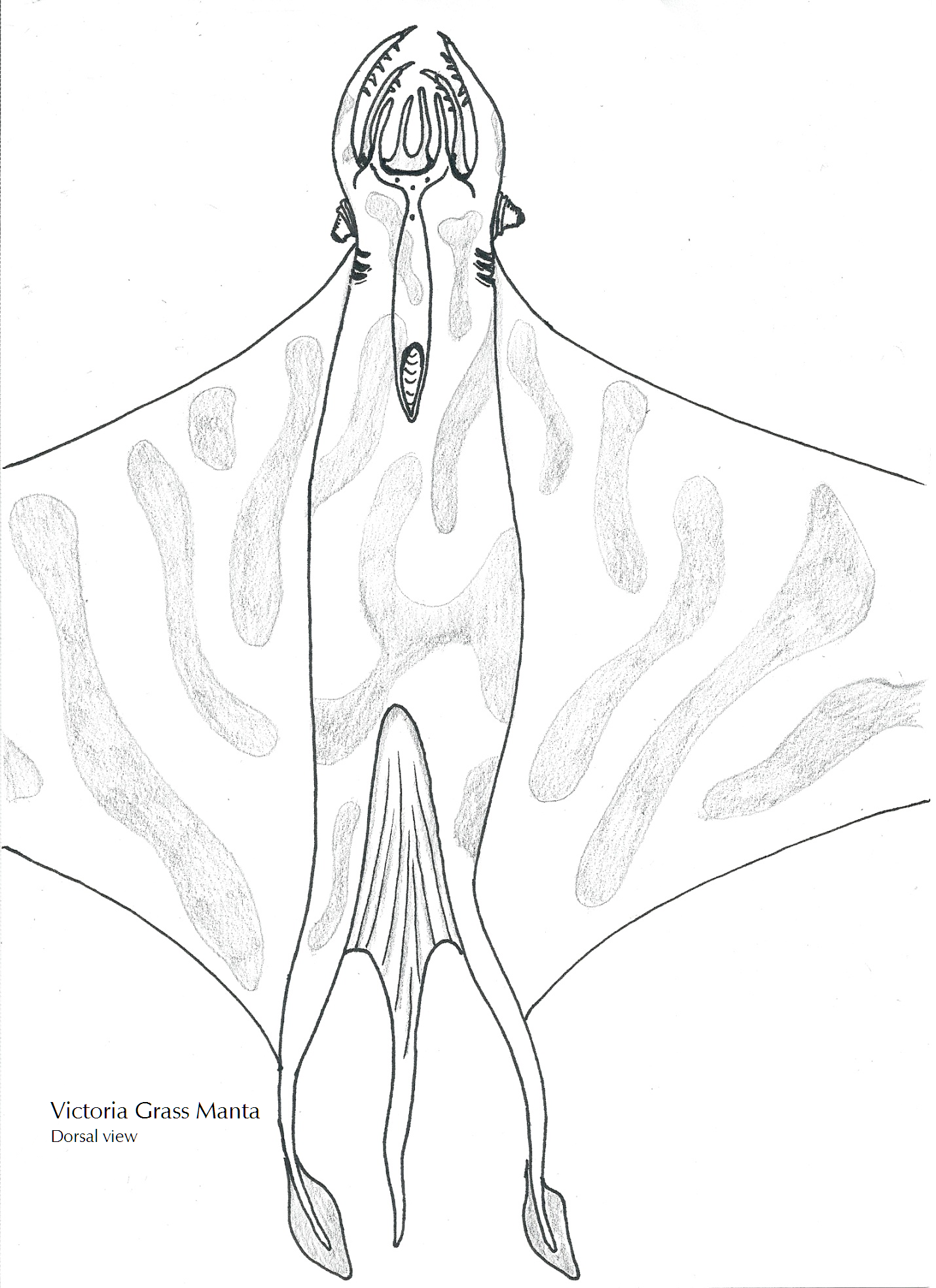Grass Manta
This article appeared in the February 2013 issue of the magazine.
| Highlands terrain | Victoria | ||||||||
| Qty | Animal | Mass (kg) | Hits | Armor | Wounds and Weapons | ||||
|---|---|---|---|---|---|---|---|---|---|
| 1 | Grass Manta (Amphibian Flyer/ Carnivore Chaser) |
275 | 18/7 | jack | 2D6 stinger* (Blade DMs) |
Land: | A(prey < 50kg) | F(if surprised) | S3 |
| Water: | A(prey < 150kg) | F(no) | S5 | ||||||
| * Also injects venom: see text for description of effects | |||||||||
The Grass Manta is the aquatic apex predator of the highland lakes (and in some of the lowland ones, too) on the major continent of the planet Victoria where the climate is temperate to alpine in range. The lakes form near the edges of cliff sides and have waterfall dropoffs that can exceed 100—200 meters tall. Rivers and wetlands that drain the rolling hills of the region during the spring and mild summer interconnect the lakes.
The Grass Manta is an amphibian flyer that masses an average of 275kg, though larger ones have been seen in the lower lakes nearer the seas where food is more plentiful and the lakes deeper. Mantas average 4.5-5m long and their triangular wings have a span of 10m. The manta has a long, tubular body with two vanes on the ends of thick tails at the posterior end, and a large maw surrounded with 8 tentacles on the anterior end. Two large complex eyes on either side of the animal’s head, just behind the maw, can move independently of each other on conical turrets. A tubular dorsal ridge along the ‘head’ above the maw has four simple eyes that detect light and shadow clustered above and between the complex eyes. Three rows of large gill slits open to the gills on either side of the head behind the eyes. The tubular ridge on top of the head runs halfway down the back and ends with a siphon opening that functions like a water jet when the manta is swimming to add a speed boost when chasing fast prey. Overall coloration for the animal ranges from green to gray-blue with dark blue marbling on the dorsal surface, and a pale gray ventral surface. This coloration makes them difficult to spot from above when they are in the water.
The maw is lined with rasping teeth and is surrounded by 4 pairs of tentacles. The upper and lower tentacle pairs are thinner than the others, and are used for manipulation of food and for probing the rocky bottoms of the lakes while looking for prey. The two pairs of tentacles bracketed by the manipulators are thicker, and stronger. These tentacles also have several rows of strong, blade-like teeth that are highly poisonous. The venom is so excruciatingly painful that it will stop any struggling by the prey held in the tentacles. The effect of the pain only lasts a few minutes, but that is sufficient time for the manta to then fly back into the water and drown its victim while beginning to tear it apart with its rasping maw. Xeno-zoologists surmise that the venom is a predatory mechanism that evolved to minimize any struggling by prey that would either injure the manta before it dove back into the lake or by struggling cause the manta to overbalance and crash into the ground where it would be helpless.
When the summer comes, the mantas enter an excited state and they fly out of the lakes where the water spills over the falls to the valleys below. The mantas then fly across the grasslands of the highlands, skimming low over the ground searching for prey. The small ungulates that live in the tall grasses, called Tick-Tocks for the sounds they constantly make while grazing, are the primary prey. A Grass Manta will swoop across the top of the grasses and snatch up a Tick-Tock in its tentacles to carry it, paralyzed by the pain from the venom, back to the lake where the manta will feed. Mantas generally hunt the Tick-Tocks, but sometimes will eat the occasional lone Glider-Wolf, the land apex predator of Victoria. The Glider-Wolves also hunt the mantas and use complex pack hunting strategies to lure the mantas into a position where the wolves can bring them to ground. Mantas have attacked humans but usually lack the mass and lift capability to carry one off to feed. Instead, the manta ends up flailing away on the ground, unable to take off, and the human paralyzed with pain for 2-3 minutes and bloodied by the animal’s teeth. Underwater it is a different story, and an attack by one is near-certain death, particularly since the scent of blood in the water draws more mantas from hundreds of meters around and they will tear at the prey item, even lashing each other in their frenzy.
During the heavy rainfall of the winter, the Grass Mantas are most since the rains and fogs keep their gills moist to allow for oxygen exchange. During the dry seasons the mantas are less plentiful and only come out of the lakes for far shorter times since they must close their gills tightly to keep them moist form the water trapped there before takeoff. During the dry season, the mantas spend the majority of their time underwater and feed primarily on the fish that swarm the depths of the lakes and rivers to mate. They also eat each other since they are cannibalistic if food is scare.

 Freelance
Traveller
Freelance
Traveller